Final report for LNE16-345
Project Information
Grass-fed dairy products are new on store shelves. The consumer demand has opened up new opportunities for organic dairy farmers of the Northeast. The market, which has developed over the past six – seven years, is a convergent of two movements: First consumers are becoming aware of the health and environmental benefits of ruminants consuming totally perennial forage diets, secondly the high cost of organic grain had a number of organic dairies reducing the feeding of grain with some giving it up totally. Farmers who evolved into the market slowly over those years, benefitted from a gradual change to their management and their herd’s genetic makeup. This allowed them a low risk entry into the new market with little difficulty. The problem was for the farmers who had produced milk with grain and desired to enter the rapidly growing grass-fed market. This project sought to identify farmers that had years of experience in producing grass-fed and collect benchmarks of their farm’s production and management. These would be shared with other farmers so they could compare their operations to those of our benchmark farms. In addition, the project sought to research forage species that fit the forage only diet of dairy cows.
The NE SARE Project “Supporting the grass-fed milk market in the Northeast with Education and Benchmarks” was a collaboration of Fay Benson with Cornell’s Extension Service, Heather Darby with University of Vermont and Sarah Flack of Flack Consulting. The area of New York and Vermont where the three collaborators worked had the highest concentration of new grass-fed dairies. The first activity of the project was to send out a survey to over 140 grass-fed dairies. There was an approximately 60% return of the survey which showed the farmer’s desire to learn more about the practice. The results provided a snapshot of this new farming enterprise including the average size of the farms, number of cows, production, acres per cow required to provide forage only diets, etc. From the first and second surveys, 21 farmers were chosen and contacted to see if they would participate in a two-year process of collection of monthly benchmark data from their farms. The monthly surveys became known as the “Grass-fed Monitor” since it was based on Cornell’s “Dairy Profit Monitor”. Both data collection activities were based on farmers entering monthly production and management numbers, they would receive back a monthly score card how their benchmarks compared to their previous responses as well as to the other farms entering data into the monitors.
The forage specie research was done by Dr. Heather Darby at the University of Vermont. Her study was determined by farmers who were asking what species of forage could deliver additional energy to a diet that was based on protein rich pastures and stored forages. Her work used research cows with direct access to their rumens. Different forage species were analyzed, packaged, and inserted directly into those rumens and were left for a period of time. The packages were removed and analyzed again to measure the cow’s ability to digest nutrients from those forages.
An additional outcome of the project will be the publication of a Grass-fed Manual which will be a combination of information and data directly from this project as well as from other sources. The manual will include farmer input collected by Sarah Flack from her extensive travel and conversations with grass-fed dairies in the Northeast.
The objective is to deliver a research and education program that allows farmers to assess if the grass-fed market is an appropriate fit for their farm and, if it is, provide management and monitoring tools that help them overcome risks associated with feeding only forage to their dairy cattle.
This project will gather and/or create tools to help farmers first assess feed quality and quantity to determine if this transition to grass-fed makes sense for their farm. This will include training on developing feed inventories, land needs calculators, and assessing rations built with their current feed quality. Farmers will also be provided access to discussion groups and online forums that allow them to build knowledge on grass-fed from experienced growers.
For current and transitioning growers, education and tools will be provided through workshops, case studies, and a grass-fed guide on strategies for improving soil, forage, and herd health under grass-fed management. These growers will have access to discussion groups and online forums to access information from other farmers and area experts. A Grass-Fed Benchmark Program will be developed and made available to participating farms to aide in record keeping, monitoring, and troubleshooting issues that may arise under the grass-fed production system.
Milk buyers are paying grass-fed farmers $1/cwt in the form of soil amendments to improve soil health and forage productivity. To help farmers understand what they can do, this project will set up soil health workshops at 4 farms in partnership with a Conservation Innovation Grant that provides a trailer with soil health measuring tools to educate farmers on how to invest this money in their soil.
Lastly, forages with high levels of metabolizable energy will be identified and rations simulated to identify potential opportunities to overcome energy and intake limitations on grass-fed farms.
Ultimately, entering the grass-fed market could be a profitable venture for farm in the Northeast given the proper management tools to navigate potential challenges associated with this production system.
Performance Target: Forty grass-fed dairies with a total 1200 cows implement new forage practices that allow the farm to meet minimum daily nutrient requirements of their herd resulting in improved herd health and leading to increased income over feed cost by $1 cow/day providing $10,950/farm to use towards other yearly farm/family expenses.
When this project was first conceived we sought input from farmers, milk processors, extension educators and researchers. There was a consensus that the emerging grass-fed market was an opportunity for small dairies of the northeast. This was evidenced by the growth in the number of grass-fed dairies in the northeast from practically none to over 150 in less than five years. The growth was due to the northeast’s closeness to a large population of consumers who were interested in the product, as well as the nutrient dense “cool season” grasses that are native to the region’s soils and topography. Many we talked to also expressed trepidation because of the lack of energy in the diet which is usually provided by grain. Some feared that dairy farms transitioning to grass-fed production could be inflicting unsafe and harmful conditions on their animals. In our proposal we shared from a conversation with Peter Miller, Northeast Regional Milk Procurement for Organic Valley. He stated that since Organic Valley had begun their grass-fed market there had been problems with cows on some farms losing body condition due to the lack of energy in the diet. Peter was in support of our project to get a two-year review of a number of grass-fed dairies to track health, body condition, and production. Shortly after beginning of our project there was two farms in New York who lost their Grass-fed Certification due to inspectors finding their cows with low body condition scoring.
Our project was designed to address these concerns in the following manner:
- Through the Grass-fed Monitor (GFM) we would collect monthly data on diet, herd health, and productivity from approximately 20 grass-fed dairies.
- The project team (especially Sarah Flack) would visit these farms to identify unique management adaptions that could be combined with the GFM data for the development of a manual on grass-fed dairy production. During these visits body condition scoring would be done to further assess health of the animals.
- Heather Darby would complete research in determining the energy value of perennial forages in the northeast.
- Throughout the project we held meetings with our GFM farmers to share results and better understand the challenges and opportunities of producing milk without grain in the diet of their cows. The project team presented at various meetings on our findings to help others interested in the grass-fed market.
Cooperators
Research
-
We hypothesize that by enlisting farmers to use the Grass-Fed Monitor (GFM) the project team will understand commonalities and measure production and financial benchmarks among grass-fed dairies. In addition the data collected will allow the project team to identify positive deviants in the group and further study the practices which led to their success. Sharing of this information will allow other organic dairy farmers to better plan their access a new milk market while maintaining or improving herd health and farm viability.
- We hypothesize that increased metabolizable energy (water soluble carbohydrates) in forage species will allow farmers to better meet the nutritional needs of cows being fed forage only.
Grass-fed Monitor: The Grass-fed Monitor (GFM) was based on a tool developed by Cargill Grain Inc. and Cornell University, theirs’s was called the “Dairy Profit Monitor”. Both monitors had dairy farmers complete a monthly survey to track: feed, milk production, health indices, plus additional categories. The results were sent back to the farmers so they could see how their benchmarks matched with the farm’s previous results as well as how they compared to other farms using the monitor. The monitors also provided research into how dairies were managing their farms. We initially started with twenty-two grass-fed dairy farmers in VT and NY who agreed to participate in the monthly benchmarking program. Each farmer filled out a monthly survey collecting data from the milk check, herd inventory, and ration to help gain an understanding of commonalities in successes and challenges in this production system. Monthly reports were generated using the monthly survey data. Each report summarized the individual farms’ data and also compared that farm to the benchmark of all the participating farms. Feedback from participants about the program, including the survey questions and reports, was sought after through one in-person farmer meeting and several written and conference call correspondence.
Energy Value of Current and Alternative Forages in the Northeast:
In field forage variety yield and quality evaluations
16 varieties of 4 perennial grass species and 20 varieties of 5 perennial legume species were evaluated for yield and quality via complete randomized block designed field experiments. The trials were harvested three times annually when the majority of the plots were in the boot or pre-bloom stage using a Carter plot forage harvester equipped with scales. At each harvest the yield of each plot was recorded and a subsample of the material taken for dry matter content determination and forage quality analyses. Once the samples were dried they were ground using a Wiley Mill to obtain a 2mm particle size and then ground using a UDY cyclone mill to obtain a 1mm grind. Once ground the samples were analyzed via a FOSS D2500 NIRS (near-infrared reflectance spectroscopy) machine. To estimate the potential milk yield produced by feeding these forages, the milk per ton system developed for alfalfa/grass by Dr. Understander at the University of Wisconsin Extension (https://fyi.extension.wisc.edu/forage/milk2016-combining-yield-and-quality-into-a-single-term/).
Laboratory forage species digestion kinetics evaluations
4 lactating Holstein cows fitted with a rumen cannula were used for an in situ experiment using a nylon bag technique. Samples of orchardgrass, sudangrass, white clover, meadow fescue and millet were collected from existing field trials in Alburgh, VT. Yields for each treatment were measured at harvest using a Carter plot forage harvester equipped with scales. Dry matter at harvest was calculated by weighing and drying a subsample of the material from each plot. Dried samples were then ground to 4 mm using a Wiley Mill. Approximately 7 g of dried, ground forage was added to pre-weighed nylon bags (Ankom Technologies), and the weight of the sample + bag was recorded. Duplicates of each forage were incubated in the rumen of each of the four cows for 1, 2, 3, 4, 6, 8.5, 19, 48, or 72 h (total of 18 bags per forage type per cow). Bags were attached to a weight in order to maintain the nylon bags in the fluid layer of the rumen. All nylon bags were removed at the end of the experiment, and washed in cold water on the gentle cycle in a washing machine. Bags that were not incubated in the rumen (time 0 h incubation) were also included in this wash cycle.
Once washed, nylon bags were placed in an oven and dried at 55C for 48 h, and the final bag + sample residue weight was recorded. Samples from each bag were submitted to DairyOne Laboratories (Ithaca, NY), for nutrient analysis. Nutrient content (% of DM) of CP, ADF, aNDF, and WSC are shown graphically below.
To calculate the DM, ADF, aNDF, and WSC disappearance (%) relative to the initial (time 0 h incubation), the following calculation was used:
Disappearance = (1-(final %/initial %)) x 100
Grass-fed Monitor Challenges:
One of our initial goals was to be able to use the monthly survey to track the volume and quality of forages fed to the milking herd and the resulting milk produced from the forage. Once we selected our farms who were going to participate we realized that there was little consistency in how the farms fed forage, which made it impossible to track and compare across the farms in the study. Since baleage was the main form of forage being fed on the farms, farmers would alter the way they fed it to provide the highest quality forage to the milking herd. A bale of baleage will weigh between 1000 -1500 lbs. per bale. As soon as the plastic is removed the baleage begins to deteriorate from oxygenation. To provide the best quality forage from the bale it needs to be eaten in 2-3 hours. Farmers had different management techniques to address this concern. For example, some farms included dry cows and bred heifers in the feeding group to make a larger group which could consume the bale quicker. Other farms allowed the milking herd first access to the bale and then let other age groups follow up to complete the bale, this gave the highest quality to the milking herd but made it impossible to track the volume consumed by the milking herd on a daily basis. For this reason, the metric of pounds of forage per cwt. of milk was not collected by this project.
In order to have usable data for the GFM it required that each farm respond monthly for the entire two years of the project. From prior experience of some of the project team there was doubt whether this could be achieved. Any breaks in a farm’s information would greatly reduce the usefulness of the averages for the benchmarks. We started with twenty-two farms, one farm dropped out after 6 months. The rest of the farms had perfect monthly response records for the two years of the project. Three farms sold their cows within the last 3 months of the project due to the sudden drop in pay price for organic milk including grass-fed milk. There were a number of reasons for this excellent monthly response record:
- Farmers stated that once they started to receive their monthly benchmark reports they were invigorated to fill out the next survey which came with the benchmark reports.
- Our NESARE proposal included $50 for each survey.
- If a farm’s survey was not received a week prior to the next mailing, we sent a reminder card. There were times when a farm became one or more months overdue. We continued to work with them to get their data caught back up.
Results Grass-fed Monitor:
We developed the GFM to achieve multiple deliverables: First to be a data collection to look for interesting production and management techniques specific to the relatively new dairy regime known as “Grass-fed” or “No Grain”. The monthly snapshot from approximately 20 farms was the first review of how dairies using this regime operated. Secondly we wanted to establish some benchmarks so farms could both rate their performance against other similarly run dairies but also for dairies considering the transition could have production data that they could use for planning purposes. Below are some of the results of the monthly 2 page – thirty-two questions survey:
Benchmarks of 22 Grass-fed Dairy Farms:
-
Average number of cows on our dairy farms: 47 cows/farm average in 2017 and 51 in 2018
-
Number of pasture acres for milking herd. 1.7 acres of pasture per lactating cow in 2017. In 2018 this dropped to 1.52 acres.
-
Number of acres used to support both milking herd and youngstock. 5.5 acres per cow on farms NOT buying or selling any forage.
-
Length of grazing season: 184 day average grazing season.
-
Average Dry Matter of forage from pasture. 80.4% in 2017 and 78.7% in 2018
-
Average Milk Urea Nitrogen during the 2017 grazing season was 12.1. and 12.4 in 2018
This final benchmark showed that these herds could achieve healthy MUN levels during the grazing season which was a surprise to the project team. More discussion on this is below in the GFM Graphs.
Grass-fed Monitor Graphs with Discussion:
GFM Data Collection and Data Sharing Forms
GFM-form-12.16
The Grass Fed Monitor (GFM) is sent to 20 dairies monthly to collect their milk production, Herd Inventory, and Forage Ration.
Insert-10.17
Insert 10.17 is an example of the monthly insert a farm gets back each month along with the GFM form for the next month. Due to processors paying for the previous month's production the GFM receives the previous month's milk production but we ask for the current month's forage ration. In the example insert the farm reported his production indicated on the November milk check which was for the milk produced in October. This information is combined with the forage ration data collected the previous month (October) to come up with the forage required to produce cwt of milk.
Energy Value of Current and Alternative Forages in the Northeast: Dr. Heather Darby
When designing this project the team identified the lack of energy as a key barrier to producing milk on a high protein and low energy diet. Dr. Darby designed the following study to look at the energy levels of native and alternative forages grown in the Northeast.
2. High Energy Forage - Heather Darby
Samples of orchardgrass, meadow fescue, orchardgrass/clover mix, pearl millet, sudangrass, and forage brassicas were collected from Borderview Research Farm from existing variety trials. Each treatment was harvested using a Carter forage harvester which harvested the standing material down to a height of about 4 inches. The perennial grass and mixture treatments were harvested 7/19/17, the second harvest of the year. Each treatment was a composite of the four varieties available in the trial in order to provide a representative sample of each species, not one variety in particular. See the table below for a complete list of varieties collected. The pearl millet and sudangrass treatments were harvested on 8/8/2017, the first harvest of the year. These samples were composed of only one variety each due to availability in the existing trial. Finally, the forage brassica treatment was a composite of eight varieties and were harvested on 10/20/2017. Approximately 42 wet pounds of material was collected for each treatment on the respective harvest date and packaged into six separate woven-poly bags and frozen in a -20°C freezer. A separate sample, of approximately 0.5 lbs, of each treatment was also frozen to be sent out for nutrient analysis via wet chemistry procedures.
All of the samples are currently being ground and prepared for lab analysis using a Wiley sample mill. In order to preserve the water soluble carbohydrate content during the grinding process, dry ice is placed through the mill to cool it first. Small amounts of the forage samples are then immersed in liquid nitrogen until thoroughly frozen. Once the mill is cold and the sample is frozen, the sample is placed into the Wiley mill and the ground material collected. The material is then re-frozen in a -20°C freezer until lab analysis can begin. As this is a very slow, careful process, the sample preparation will continue into early 2018 while the rest of the laboratory equipment is set up and tested. The lab analysis will be done via dual-flow continuous culture fermenters to investigate the effect of these species on ruminal digestion and nutrient flow. Currently the equipment is being cleaned, set-up, and tested through a trial run using TMR feed samples collected through another project. Once the fermenters are confirmed to be functioning smoothly analysis of this project’s samples will begin.
2018 High Energy Forage Report - Heather Darby, Univ VT.
The data collection of the GFM allowed researchers and farmers to put numbers to dairy operations and evaluate where each dairy stood as far as base acreage, production, and management styles. During the project we held three participant discussion meetings and there were numerous one on one meetings with farmers. With numbers in hand these conversations were particularly valuable in identifying recommendations for success in the grass-fed dairy production. These are now synthesized in Grass-fed Dairy Production a manual produced by the University of Vermont which used information generated by this project. Here is an excerpt from that manual:
Success with grass-fed dairy management requires excellent management skills and a well-thought out
plan. Key factors for success include managing to produce (or buy) high quality forages AND manage to
maximize forage dry matter intake. Increasing the acreage, purchasing more forages, or decreasing herd
size may be necessary when converting to an all-forage system. Changing the herd genetics and
selection criteria may also be needed, along with careful monitoring of the herd.
The approach that each farm is taking on managing to maximize forage intake, maintaining herd
performance and wellbeing, and milk production varies greatly. Although there are some common
management practices shared by successful grass-fed farms, there is overall a wide range grass-fed
management practices. Each farm will need to find their own “best” system. Some farms may find that
being grass-fed is not a good match for them, while others will find that their farm well-suited to this
system.
Summary of suggestions for grass-based dairy farmers
Maximize dry matter intake of forages. This requires highly digestible high-quality forages.
Look for lower NDF values on the forage tests with high energy and enough (but not too
much) protein.
Higher digestibility is necessary to allow cows to eat a larger quantity of forage to replace
the nutrition they were previously getting in their grain.
Improve forage quality through:
Improved plant species,
Earlier harvest,
Improved harvesting & storage methods, and
Improving soil fertility.
Larger amounts of forage per cow will be needed. This may require:
Adding more land to the pastures as paddock sizes have to be increased, and
Adding more land for harvested/stored forages or buying more high quality forage.
Monitor herd performance and wellbeing by:
Monitoring body condition,
Monitor rumen fill constantly,
Manure scoring.
Monitoring MUNs is helpful in making sure the cows are getting the right rations, and
Monitor reproduction to make sure cows are breeding back on time and staying bred.
Feed enough of the right types of mineral supplements. Forages will not be able to provide all
the minerals needed by the herd!
Select for the right herd genetics.
Make sure that the level of milk production with no grain will bring in enough income to keep
the farm financially sustainable.
Whole farm nutrient balance management will likely require more off-farm fertility inputs.
Education
The education approach can be divided into two main audiences:
- The Grass-fed farmers that we work with and collect data from
- The farmers, processors, and educators who are interested in learning more about Grass-fed dairy production.
For farmers in the first group; Our goal was to use the power of benchmarking to help farmers see how their farm performs over the period of time and also how their farm compares to the other farms in the project. Our collection of the data through the monthly Grass-fed Monitor (GFM) will allow us to provide feed intake, production numbers, and milk components to individual as well as the twenty farmers in the study. Farmers will review this information monthly and evaluate any areas that they can improve. In order to do this, they will need to “drill down” to understand the root cause of the issue and determine a corrective action. This will be the teachable moment. The farmers can then use GFM data to monitor any changes due to the corrective action. Monthly contacts and at least 2 farm visits by the program team will provide farmers with opportunity for outside input.
The second group will benefit from this first time look into a dairy production style which is unique. The information collected will be shared through different formats so that farmers and others will be able to evaluate whether Grass-fed production is an opportunity for other farms.
Both groups will receive education through the numerous outreach events during the project by the project team.
2018 Report on Education
The farmers who participated in the GFM reported that the monthly benchmark reports were useful to compare how their performance on such items as Milk Production, Milk Quality, Pasture usage, Milk Urea Nitrogen, etc. compared to other farms in the study. One farmer used the reports to monitor his benchmarks when he changed from two times a day milking to one milking per day. Further reports are included in the Milestone section.
The second group of farmers we intended to interact with were reached through numerous on farm events and conferences and an article written by Sarah Flack for GRAZE magazine
Milestones
100 organic dairy farms currently or interested in selling to the grass-fed market will learn about the education
and benchmarks program through mail and receive a survey to document current practices and production.
November/December 2016
100
2
140
3
December 30, 2016
Completed
December 30, 2016
With the help of Grass-fed Processors: Organic Valley Co-op and Maple Hill, one hundred and forty surveys were sent to grass-fed dairies in NY and VT.
75 farmers return survey; 60 farmers agree to participate in program; 25 farmers agree to participate in
development of the “Grass-Fed Benchmark Program”. January 2017
75
81
2
January 05, 2017
Completed
January 05, 2017
Of the 140 initial surveys we had 81 farmers return their surveys. The project team was surprised to get such a high percentage of returns (58%). We believe part of the success was due to farmers support for this project. Care was also taken in designing of the survey to make it easy to respond yet still get important information. As a last question on the first survey we asked whether the farmer would be willing to participate in a second more extensive survey. Seventy-five farmers agreed to receive the in-depth survey and we received 40 responses. These two surveys provided us with valuable information we have begun sharing with farmers and industry personnel. The final group of respondents also became our list to ask about participating in the next level of the project which was the “Grass-fed Monitor”
25 grass-fed farms visited and surveyed and basic baseline farm data, feed costs, and animal health data
collected. Monthly recordkeeping and monitoring instituted on the 25 farms. February-December 2017
25
20
December 29, 2017
Completed
December 29, 2017
Sarah Flack and Fay Benson visited each of the dairies that agreed to be in the GFM during the winter of 2016-17. Each farm was evaluated and informed as to the required monthly information which was going to be required. Fay purchased a scale to weigh both forage and animals on the farm to increase the accuracy of the data collected.
The first GFM was sent out in April 2 months behind schedule. This version was too indepth for farmers so with their input the GFM was revised and sent out in May. That version can be seen here. GFM-form-12.16
250 farmers attend organic dairy winter conferences and learn of the project goals and provided with compiled
grass-fed farm resources. Farmers learn how to calculate feed inventories and match land base to feed needs.
March 2017
250
260
2
March 30, 2017
Completed
March 30, 2017
SARE-Summary-updated-by-Sarah-Aug17
Sarah Flack was invited to speak at the Maple Hill Producers meeting in fall of 2016. There were 60 farms in attendance for her talk on factors required to have successful livestock production on forage only feeding. In March of 2017 Sarah also spoke to 100 farmers at the VT Organic Dairy Conference.
Fay Benson spoke at the NOFA-NY Organic Dairy and Filed Crop Conference. His topic was an overview of the survey responses for the Grass-fed project, audience totaled 35 producers. Fay also presented a poster at the NE Pasture Consortium. Here is the Abstract developed for that event: SARE-Grass-fed-Dairy-Abstract
Sarah Flack also made 40 farm visits to grass-fed dairy producers during this period.
100 attend on-farm field days hosted by grass-fed farms and learn about soil, pasture and forage management
strategies to optimize yield and quality. July-September 2017
100
380
25
September 15, 2017
Completed
September 29, 2017
The "NY Soil Health Trailer was used to demonstrate to farmers how management affects their soil's ability to recharge the water capacity, recycle nutrients, and protect water quality. There were 6 events during the summer of 2017. Three in VT and three in NY. Here is the list of events with participant numbers:
| 15-Aug | VT Sustainable Research Farm | Charolette VT | Dr. Juan Alvez | 40 | |||
| 16-Aug | Caring Dairy Soil Training | Holland VT | Ben&Jerry's | 19 | |||
| 17-Aug | Soil Health | Franklin VT | Dr. Heather Darby UVT | 35 | |||
| 23-Aug | Glynwood Incubator Farm | Cold Springs NY | Dave Llewellyn | 25 | |||
| 30-Aug | Organic Valley Soil Training | Virgil, NY | Ann Phillips | 38 | |||
| 29-Sep | NE Organic Dairy Producer Asso. | Truxton NY | NE Organic Dairy Producer | 75 | |||
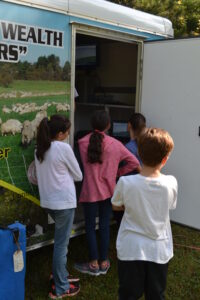
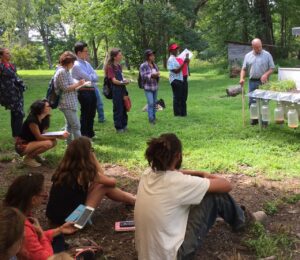
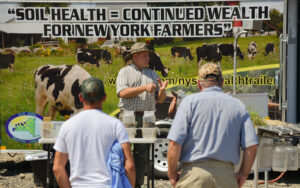
250 attend organic dairy winter conferences learn about first year Grass-Fed Benchmark Program results
including challenges, benefits, and successes. Farmers learn nutrition requirements for dairy cows, including
stress indicators of not meeting or exceeding nutritional needs. March 2018
25 Grass-fed farms visited and year 1 benchmark data shared, challenges identified, and strategies put into
place to overcome issues. Monthly recordkeeping/monitoring continued. February-December 2018
250
301
December 31, 2018
Completed
December 12, 2018
Included in this milestone are:
- 2018 Conference Presentation by the Project Team
- Due to the the interest in Grass-fed market our participation at winter conferences was greater than expected. In addition to local and state conferences we were invited to speak at the Regional Northeast Pasture Consortium meeting and the National Grazinglands Coalition in Reno NV (for specific locations see Google sheet link at the bottom).
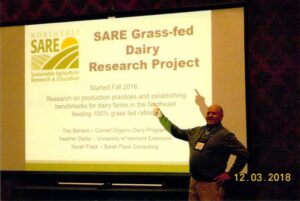
- Monthly "Grass-fed Monitor" (GFM) data collection on 20 dairies: This has been the main focus of our project as we collect milk and milk component production data over the year in addition to forage feeding and production data. We have been very appreciative of the cooperation of the farmers who have worked with us during the past 18 months. We started with 21 farms in the GFM. One farmer dropped out in the first year and two additional farms sold their cows and left the market this year. The continued participation in the project was an indication of the benefit farmers received from completing the monthly survey.
- We held a winter and a summer meeting with our farmers on the GFM. The winter meeting was held in Oriskany NY and St Albans VT and we connected the two meetings by webinar. Farmers who were unable to attend this meeting in person were also able to connect through the webinar.
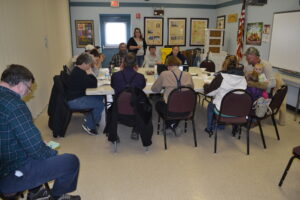
3/21/18 Farmers met at two sites and were connected by Webinar to hear SARE Updates on the GFM. - The summer meeting of the GFM farm families was held in Laurens NY. We included a soils presentation on how pasture nutrients are recycled by soil.
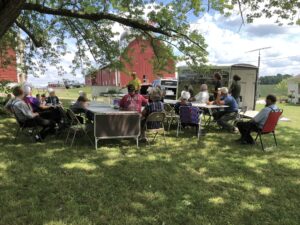
The Summer picnic on 7/26/18 included a tour of Tafel Dairy Farm owned by Adam and Margaret Tafel in Laurens NY. We used the Soil Health Trailer in a presentation on how nutrients are recycled in pastures.
- We held a winter and a summer meeting with our farmers on the GFM. The winter meeting was held in Oriskany NY and St Albans VT and we connected the two meetings by webinar. Farmers who were unable to attend this meeting in person were also able to connect through the webinar.
The GFM farmers enjoyed and benefited from these meetings. Some of the conversations overheard were about "once a day milking". Only one farm practiced this at the beginning of the project and after our winter meeting two more dairies adopted the practice. Karl Brown of Eaton NY reached out to Jon and Miranda Powers of Holland Patent NY to get more information on the practice and eventually tried it in the spring of 2018. He credited the GFM as a good bench-marking tool to watch for changes on his farm as he made this production change. He says the adoption of once a day milking has "Put the romance back into farming."
As we moved into April of 2018 the GFM now had a years worth of data to send back each month so farmers could now benchmark the previous years's production.
For a detailed view of contacts completed by the work team see SARE Outreach Tracker.
100 attend on-farm field days and learn about practical soil care and high-energy forage crops. Grass-Fed
Benchmark Program tools are shared and farmers learn how to calculate their income over feed costs. July-
August 2018
80
20
1000
38
September 30, 2019
Completed
August 21, 2019
Vermont Grass-fed Dairy Outreach Summers of 2018 and 2019 (892 attendees)
VT Organic Dairy Producers Conference. Randolph, VT. March 15th, 2018. 94 attendees.
On-farm organic dairy workshop @ JASA Farm. Newport, VT. July 24th, 2018. 28 attendees.
On-farm organic dairy workshop in Graniteville. Graniteville, VT. July 25th, 2018. 42 attendees.
Northwest Crops and Soils Program Annual Field Day. Alburgh, VT. July 26th, 2018. 213 attendees.
On-farm organic dairy workshop at Ottercrest Dairy. Witing, VT. August 6th, 2018. 14 attendees.
Pasture resiliency on-farm workshop at Sweet Rowan Farm. Albany, VT. August 9th, 2018. 51 attendees.
VT Organic Dairy Producer’s Conference. Randolph, VT. March 14th, 2019. 114 attendees.
Grass-fed dairy production and land reclamation workshop. Constable, NY. July 11th, 2019. 26 attendees.
Northwest Crops and Soils Program Annual Field Day. Alburgh, VT. July 25th, 2019. 237 attendees.
Grass-fed dairy production systems workshop. Charlotte, VT. August 8th, 2019. 20 attendees.
Overcoming dairy production challenges workshop. Walpole, NH. August 12th, 2019. 23 attendees.
Grass-fed dairy and forage production workshop. Highgate, VT. August 28th, 2019. 30 attendees.
Utilizing the Soil Health Trailer events allowed us to reach a large number of farmers and share the results to date of the Grass-fed project. Information gathered from the project was also shared such as:
- The cost of inefficient grazing when forage is the only feed for animals. The average acreage of our test farms was 6 acres per adult animal.
- The GFM farmers reported 1.7 acres per cow used for pasture in 2017 as a benchmark. Improving efficiency in grazing was one area the project team focused on. That figure reduced to 1.52 acres in 2018. If I use $3,000 / acre as a land cost and farmers are using 0.18 acres less it was a savings of $540 over the grazing period or 200 days. This gave us the verifiable impact of $324,000 for the 20 farms on the GFM or $16,200 / farm. In our Performance Target we said we would impact cost of forage use by $10,950 / farm.
50 farmers consult about grass-fed transition, challenges and successes and other timely topics chosen by the
farmers attending each discussion group or online forum. Ongoing.
50
150
October 31, 2019
Completed
October 31, 2019
March 21st 2018 a joint meeting was held in New York, at the Oneida County CCE Office and in Vermont at the UVM Extension in St. Albans. We also established a Zoom webinar connection to connect these two sites and for farmers that could not travel to the meeting sites.
40 grass-fed farmers improve forage quality and document improved herd health.
40
60
October 31, 2019
Completed
October 31, 2019
To wrap up the project we sent out an information packet with the Benchmarks shown below to about 60 farmers we had contact with during the 2.5 years of this project. We also included a post card for comments they could return. We only received 22 responses of improvements attributed to the project. Also included below are comments received.
| Farmer's Comments in Wrap-Up Survey |
| We strive to keep it simple. We don’t attend much fancy meetings on grass-fed etc. |
| Help measure our farms efficiency according to fellow grass farmers |
| Ability to learn from other grass farmers |
| Helped me see how my farm compared to others in SCC, MUN, mineral supplementation, milk production & pasture rotation |
| Evaluation potential future transition to no-grain dairy |
| I appreciate the information sheets I just received with this post card. It's reassuring to see how our numbers compared to those of other farms. This is the first info we received from your project I believe |
Milestone activities and participation summary
Participation summary:
Learning Outcomes
Change in milking frequency:
During the GFM meetings held in 2017 one farmer shared that they only milked once a day. This was a unique change in the traditional twice a day milking employed by dairy farms except for the dairies that have such high production they found it beneficial to milk three times a day. It made sense that if a cow's production drops below a certain point it would be feasible to change to once a day milking. Of the 20 dairies that participated in the GFM we had two additional dairies that transitioned to once a day milking. These two farms had their GFM monthly reports to track their production and quality metrics as they made this change. During a farm visit to one of the farms that made the change he commented that making the change "Put the romance back into dairying" Since it freed up 2-3 hours of every day. In addition to the milking time he saved time on sanitizing the milking equipment, cleaning up after milking, and bringing cows in from pasture. He saved money on electricity and cleaning chemicals.
He found that there was loss in the volume of milk but the pounds of milk fat and protein remained nearly constant. He advise others who were interested in making the change to do so at the beginning of the lactation and monitor somatic cell counts. Once the cows became used to it the benefits far out weighed the challenges.
Being more productive with acres:
Our study showed that grass-fed farmers were using 5.5 acres per milking cow. This figure was arrived at by separating out farms that sold some forage off farm so we used total acres that were used to support the milking herd and the young stock. The project team showed how even though cost per acre varied for the farms it was still a significant overhead cost when including taxes and opportunity cost. Farmers reported that land efficiency was the reason the GFM saw the average milking herd size increase by 9% from 47 in 2017 and 51 in 2018.
Performance Target Outcomes
Target #1
40
Farmers involved with the monthly data collection of the Grass-fed Monitor (GFM) will use the benchmarks that evolve to better manage their cost of production with particular focus on forage utilization. This includes pasture utilization and forage harvest and storage.
The survey completed in the first year of the project provided a fairly accurate number of acres grass-fed dairy farmers were using to support their milking herd including young stock. (5.5 acres). This figure was presented at all meetings, articles, and discussion groups during the project. Since real estate is the largest investment on these farms any reduction of acres per cow will decrease the cost of production for the farm.
Forty grass-fed dairies with a total 1200 cows implement new forage practices that allow the farm to meet minimum daily nutrient requirements of their herd resulting in improved herd health and leading to increased income over feed cost by $1 cow/day providing $10,950/farm to use towards other yearly farm/family expenses.
22
Total forage production on the farms was collected on the GFM but how it was distributed between the milking herd, youngstock, and other livestock was too difficult to track. The forage figure we collected which we could verify any changes to the cost of production was the pasture acreage used for the milking herd. We saw a significant increase in milk per acre during the the project period. Using the complete GFM data collected shown below we were able to review the reduction in acres required to produce Fat Corrected Milk. This reduction in acres meant that these acres could be used to either support an increase of milking animal or for stored forage production to be sold off the farm.
The GFM showed that in 2017 the farmers were using 1.7 acres per milking animal per day for pasture. By the end of 2018 this figured dropped to 1.52 acres of pasture to produce essentially the same amount of milk. The result was that each cow required 0.18 acres of land less to produce the farm’s milk.
Using an average value of pasture acreage at $3000/acre the acreage reduction to produce the same amount of milk equaled $540 per cow for the farms. Our farms averaged 45 cows per farm so the average savings per farm equaled $24,300
Our project was titled “Supporting the Grass-fed Milk Market of the Northeast with Benchmarks and Education” The backbone of the project was the Grass-fed Monitor the monthly survey which was completed by 22 farms in the beginning and 19 by the end. One farm dropped out after 6 months and 2 sold their cows after participating for 20 months and the other for 21 months. Each farm filled out a 50+ question survey each month with data collected on milk volume, with components, quality, forage used, and harvested, amount of labor, management, and livestock on the farm. See the complete data spread sheet below titled “GFM Data”.GFM Data
This data provided the benchmarks that were used by the 20 or so farmers involved in the project to view their performance compared to the other farmers. Each month farmers received an individualized report on how their farm compared to the other farms on milk production, how their current production compared to a year ago, and then we selected another survey question from the survey so they could again see how their farm’s benchmark compared to the others on that particular question. Below was January 2018 “Insert” on individualized reports. There were approximately 20 reports created each month for the 24 months of data collection. For the one shown below we reported the usual graph on how the farm’s production compared to itself the previous year, and also how the farm’s production compared to the other farms for the previous month. The additional graph we chose for that month was how their farm’s grazing season compared to the other farms grazing season. Normally each report contained the farm’s name and code number but only referred to the other farms by their code number. For the one shown below all names were removed. Insert 1.18 no names
Additional Project Outcomes
The OREI Grant includes collaborators from Univ. VT, Univ. NH, Tuffs Univ, and The ARS Pasture Lab at Penn State. The multi-year research project, titled Advancing Grass-Fed Dairy: A Whole Systems Approach to Enhancing Productivity, Quality, and Far Viability in the U.S., seeks to identify critical components of grass-fed dairy management that support high quality milk production, herd health, environmental health, and farm economic viability, while contributing to a vibrant grass-fed dairy market that meets the needs and preferences of consumers. It will continue the Grass-fed Monitor on a national level.
The Grass-fed Dairies benefitted from multiple activities of this project but some of the most useful benefits came from the activities where we had farmers come together either on farms or in classrooms. One area of particular interest was that one farmer told they were only milking once a day. This was possible since the cows were only making 1/2 as much milk as a grain fed animal. Two of our GFM group followed up with that farmer and eventually converted their farms to once a day milking. One New York farmer stated "Going to once a day milking put the romance back into dairy farming" since he now had more time to do school activities with his kids.

The grant paid for a low cost scale that was modified to either weigh cows or feed items such as: carts of silage, small hay bales, or baleage. The farms the scale was used on benefited from more accurate knowledge of what the animal were eating which helped determine cost of production. It also helped know what the production of their fields were. At one dairy the farmer was overestimating the weight of their baleage by 18%.
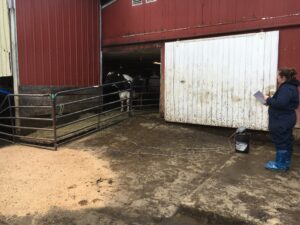
This project was exceptionally successful keeping farmers involved and responding to the monthly requests for information on the Grass-fed Monitor for 2 years. We had only one farm drop out of the beginning 22 farms and 3 others that sold their cows nearly at the end of the project due to the down turn in organic milk prices. There were a number of reasons for the uninterrupted participation. The project leader had been a farmer and knew what a farmer's kitchen table looked like and how mail builds up and some never gets opened. For this reason we bought "ugly" yellow envelopes and had them printed with the statement "Your Grass-fed Monitor". In addition farmers knew that inside was their own farm's report on how they compared to the other farms in the project. A number of farmers stated the best part of being involved with the project so they could compare their management benchmarks to other farms that produced milk with grass-fed management.
By making the envelope identifiable, it improved the dependability of farmers responding to monthly requests.
